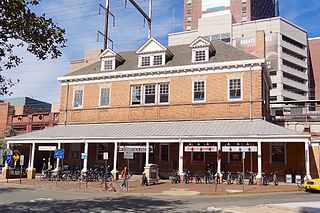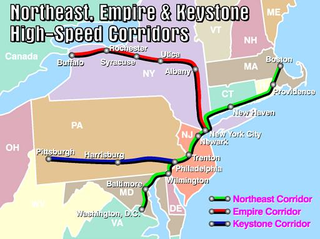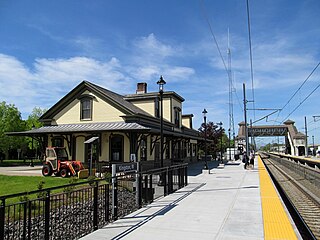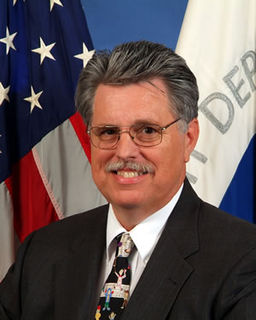Related Research Articles

The Acela Express is Amtrak's flagship service along the Northeast Corridor (NEC) in the Northeastern United States between Washington, D.C. and Boston via 14 intermediate stops, including Providence, Baltimore, Philadelphia, and New York City. The route contains segments of high-speed rail, and Acela Express trains are the fastest trainsets in the Americas; they attain 150 mph (240 km/h) on 33.9 mi (54.6 km) of the route.

Bus rapid transit (BRT), also called a busway or transitway, is a bus-based public transport system designed to improve capacity and reliability relative to a conventional bus system. Typically, a BRT system includes roadways that are dedicated to buses, and gives priority to buses at intersections where buses may interact with other traffic; alongside design features to reduce delays caused by passengers boarding or leaving buses, or purchasing fares. BRT aims to combine the capacity and speed of a metro with the flexibility, lower cost and simplicity of a bus system.

The Northeast Corridor (NEC) is an electrified railroad line in the Northeast megalopolis of the United States and the busiest rail corridor in the Western Hemisphere. Owned primarily by Amtrak, it runs from Boston through Providence, New Haven, New York City, Philadelphia, Wilmington, and Baltimore to Washington, D.C. The NEC closely parallels Interstate 95 for most of its length, and is the busiest passenger rail line in the United States both by ridership and by service frequency as of 2013. The NEC carries more than 2,200 trains daily. Branches to Harrisburg, Pennsylvania, Springfield, Massachusetts, and various points in Virginia are not considered part of the Northeast Corridor, despite frequent service from routes that run largely on the corridor.

The Southeast Corridor (SEC) is a proposed passenger rail transportation project in the Mid-Atlantic and Southeastern United States to extend high-speed passenger rail services from Washington, D.C. south through Richmond, Petersburg with a spur to Norfolk in Virginia through Raleigh, Durham, Greensboro and south to Charlotte in North Carolina and connect with the existing high-speed rail corridor from D.C. to Boston, Massachusetts known as the Northeast Corridor. Since first established in 1992, the U.S. Department of Transportation (USDOT) has extended the corridor to Atlanta, Georgia and Macon, Georgia; Greenville, South Carolina; Columbia, South Carolina; Jacksonville, Florida; and Birmingham, Alabama.

The Federal Railroad Administration (FRA) is an agency in the United States Department of Transportation (DOT). The agency was created by the Department of Transportation Act of 1966. The purpose of FRA is to promulgate and enforce rail safety regulations, administer railroad assistance programs, conduct research and development in support of improved railroad safety and national rail transportation policy, provide for the rehabilitation of Northeast Corridor rail passenger service, and consolidate government support of rail transportation activities.

The Intermodal Surface Transportation Efficiency Act of 1991 is a United States federal law that posed a major change to transportation planning and policy, as the first U.S. federal legislation on the subject in the post-Interstate Highway System era.

Plans for high-speed rail in the United States date back to the High Speed Ground Transportation Act of 1965. Various state and federal proposals have followed. Despite being one of the world's first countries to get high-speed trains, it failed to spread. Definitions of what constitutes high-speed rail vary, including a range of speeds over 110 miles per hour (180 km/h) and dedicated rail lines. Inter-city rail in the United States with top speeds of 90 miles per hour (140 km/h) or more but below 125 mph (201 km/h) is sometimes referred to as higher-speed rail.

New Brunswick is a railroad station in New Brunswick, New Jersey. It serves Amtrak and NJ Transit trains on the Northeast Corridor. The station is located at the intersection of Easton Avenue and French and Albany Streets, near the College Avenue Campus of Rutgers University.

High-speed rail in New York has been a topic that is consistently discussed among legislators, political leaders and in particular, several past governors since the 1990s, but thus far little progress has been made. In his campaign speeches prior to his defeat by Governor George Pataki in 1994, Mario Cuomo promised to bring high speed (maglev) rail up the Hudson Valley and along the Catskill Mountains route. It was not a priority for the subsequent administration.
The Baltimore–Washington Superconducting Maglev Project is a proposal from the United States cities of Baltimore, Maryland, and Washington, D.C., to build a 40 mi (64 km) maglev train system between their respective central business districts. It is the first segment of the planned Washington-New York Northeast Maglev project.

Kingston is a historic railroad station located on the Northeast Corridor in the village of West Kingston, in the town of South Kingstown, Rhode Island. It was built at this location in 1875 by the New York, Providence and Boston Railroad, replacing earlier stations dating back to the opening of the line in 1837. Current rail services consist of Northeast Regional trains in each direction, all of which stop at the station. Historically Kingston provided commuter rail service to Providence and Boston via Amtrak's commuter rail services. The MBTA is looking at extending their commuter service with the Providence/Stoughton Line.

The Hartford Line is a commuter rail service between New Haven, Connecticut, and Springfield, Massachusetts, using the Amtrak-owned New Haven–Springfield Line. The project is a joint venture between the states of Connecticut and Massachusetts, with support from the federal government as well. CTrail-branded trains provide service along the corridor, and riders can use Hartford Line tickets to travel on board most Amtrak trains along the corridor at the same prices. The service launched on June 16, 2018.

Positive train control (PTC) is a system of functional requirements for monitoring and controlling train movements and is a type of train protection system. The term stems from control engineering. The train is only allowed to move in case of positive movement allowance. It generally improves the safety of railway traffic.

Joseph Houston Boardman was an American transportation executive who served as President and CEO of Amtrak from 2008 to 2016. Boardman was the longest-serving Commissioner of the New York State Department of Transportation (NYSDOT) from July 1997 until resigning to head the FRA. Before taking over Amtrak, Boardman had been the Administrator of the United States Federal Railroad Administration. Boardman became the second-longest serving head of Amtrak, after W. Graham Claytor, Jr. in the 1980s. Railway Age magazine named Boardman as its 51st "Railroader of the Year" in its January 9, 2014, issue.
Rail speed limits in the United States are regulated by the Federal Railroad Administration. Railroads also implement their own limits and enforce speed limits. Speed restrictions are based on a number of factors including curvature, signaling, track condition, the physical condition of a train, and the presence of grade crossings. Like road speed limits in the United States, speed limits for rail tracks and the trains that run on them use miles per hour (mph).
The National Maglev Initiative (NMI) was a research program undertaken in the early 1990s by the United States Department of Transportation, U.S. Army Corps of Engineers, Department of Energy, and other agencies which studied magnetically levitated, or "maglev", train technology, operating at speeds around 300 miles per hour (480 km/h). The effort was created in April 1990 and released a report in 1993. The Intermodal Surface Transportation Efficiency Act of 1991 (ISTEA) authorized $725 million in funds for maglev research, pending the results of the NMI study, but an appropriation of funds was also required, and it's not clear if that ever occurred.
An Advanced Traveller Information System (ATIS) is any system that acquires, analyzes, and presents information to assist surface transportation travellers in moving from a starting location (origin) to their desired destination. An ATIS may operate through information supplied entirely within the vehicle or it can also use data supplied by the traffic management centres. Relevant information may include locations of incidents, weather and road conditions, optimal routes, recommended speeds, and lane restrictions, all part of the Intelligent transportation system or ITS.

Transportation Technology Center, Inc. (TTCI), is a railroad testing and training facility located northeast of Pueblo, Colorado. It originated as the Department of Transportation's High Speed Ground Test Center as a site to test several hovertrain concepts. When those projects were completed in the 1970s, the site was handed to the Federal Railroad Administration (FRA). TTCI was formed on January 1, 1998, as a wholly owned subsidiary of the Association of American Railroads (AAR).

Higher-speed rail (HrSR), also known as high-performance rail, higher-performance rail, or almost-high-speed rail, is a jargon used to describe inter-city passenger rail services that have top speeds of more than conventional rail but are not high enough to be called high-speed rail services. The term is also used by planners to identify the incremental rail improvements to increase train speeds and reduce travel time as alternatives to larger efforts to create or expand the high-speed rail networks. Some countries use the term medium-speed rail, or semi-high speed rail instead.
References
- ↑ "79 Stat. 893" (PDF). Retrieved 2013-05-18.
- ↑ "General Records of the Department of Transportation, Record Group 398, 1958-92" . Retrieved 2013-05-18.
- ↑ "The Needs and Desires of Travelers in the Northeast Corridor" . Retrieved 2013-05-18.